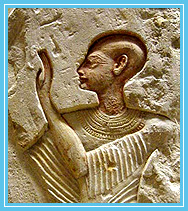|
|
| |
| |
 |
| |
The Old Kingdom (about 2755-2255 BC) spanned five centuries of rule by the 3rd through the 6th dynasties. The capital was in the north, at Memphis, and the ruling monarchs held absolute power over a strongly unified government. Religion played an important role; in fact, the government had evolved into a theocracy, wherein the Pharaohs , as the rulers were called, were both absolute monarchs and, also gods on earth. |
 |
|
| |
|
|
| |
The 3rd Dynasty was the first of the Memphite houses, and its second ruler, Zoser,or Djoser, who reigned about 2737-2717 BC,emphasized national unity by balancing northern and southern motifs in his mortuary buildings at Sakkara . His architect, Imhotep, used stone blocks rather than traditional mud bricks in the complex there, thus creating the first monumental structure of stone; its central element, the Step Pyramid, was Zoser's tomb. In order to deal with affairs of state and to administer construction projects, the king began to develop an effective bureaucracy. In general, the 3rd Dynasty marked the beginning of a golden age of cultural freshness and vigor |
|
| |
|
|
| |
The 4th Dynasty began with King senfru, whose building projects included the first true pyramid at Dahshor (south of sakkara ). Snefru, the earliest warrior king for whom extensive documents remain, campaigned in Nubia and Libya and was active in the Sinai. Promoting commerce and mining, he brought prosperity to the kingdom. Snefru was succeeded by his son Khufu (or Cheops), who built the Great Pyramid at Giza. Although little else is known of his reign, that monument not only attests to his power but also indicates the administrative skills the bureaucracy had gained. Khufu's son Redjedef, who reigned about 2613-2603 BC, introduced the solar element (Ra, or Re) in the royal titular and the religion. Khafre (or Chephren), another son of Khufu, succeeded his brother to the throne and built his mortuary complex at Giza. The remaining rulers of the dynasty included Menkaure, or Mycerinus, who reigned about 2578-2553 BC; he is known primarily for the smallest of the three large pyramids at Giza. |
|
| |
|
|
| |
Under the 4th Dynasty, Egyptian civilization reached a peak in its development, and this high level was generally maintained in the 5th and 6th dynasties. The splendour of the engineering feats of the pyramids was approximated in every other field of endeavour, including architecture, sculpture, painting, navigation, the industrial arts and sciences, and astronomy; Memphite astronomers first created a solar calendar based on a year of 365 days. Old Kingdom physicians also displayed a remarkable knowledge of physiology, surgery, the circulatory system of the body, and antiseptics. |
|
| |
|
|
 |
|
| |
Although the 5th Dynasty maintained prosperity with extensive foreign trade and military incursions into Asia, signs of decreasing royal authority became apparent in the swelling of the bureaucracy and the enhanced power of no royal administrators. The last king of the dynasty, Unas, who reigned about 2428-2407 BC, was buried at sakkara , with a body of religious spells, called Pyramid Texts, carved on the walls of his pyramid chamber. Such texts were also used in the royal tombs of the 6th Dynasty. Several autobiographical inscriptions of officials under the 6th Dynasty indicate the decreasing status of the monarchy; records even indicate a conspiracy against King Pepi I, who reigned about 2395-2360 BC, in which the ruler's wife was involved. It is believed that during the later years of PepiII, who reigned about 2350-2260 BC, power may have been in the hands of his vizier (chief minister). Central authority over the economy was also diminished by decrees of exemption from taxes. The Nomes (districts) were rapidly becoming individually powerful, as the monarchs—governors of the districts—were beginning to remain in place rather than being periodically transferred to different Nomes. |
|
| |
|
|
| |
 |
|
|
|
|
|
|
|
|
